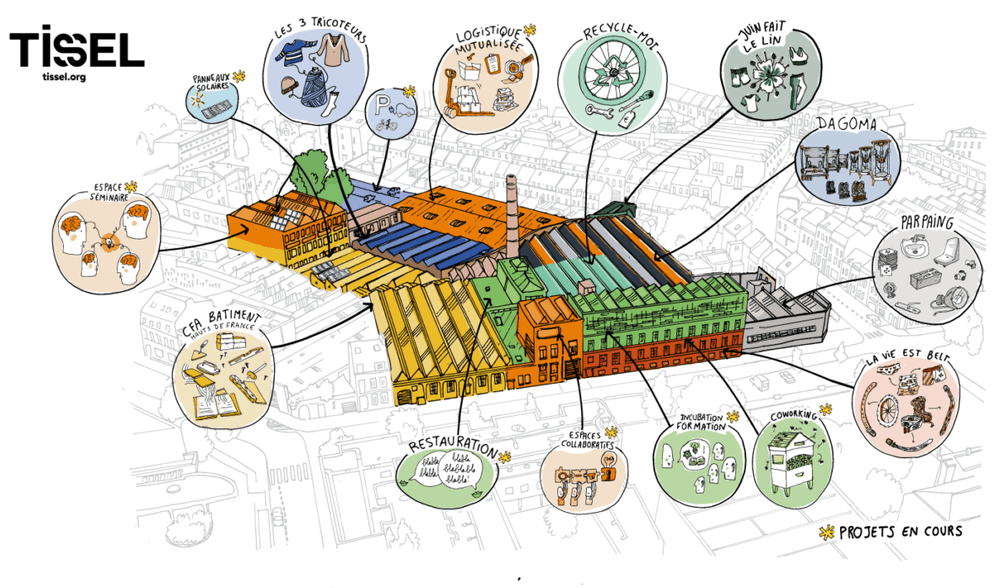Tissel: A Circular Economy Innovation Factory
Four of the DEFINITE-CCRI projects were recently selected for the due diligence phase of the DEFINITE-CCRI project development assistance (PDA). To deep-dive into these innovative circular solutions, we’re publishing a series of interviews with project developers. For the final interview in this series, we sat down with Hugo Delahaye, Chief Project Officer for the Circular Economy and European Projects at the City of Roubaix, who introduced us to the Tissel project in Roubaix, France.
Please introduce your project in a pitch format and share its origin story. What inspired the initial idea, and how did you take it from concept to reality?
The Tissel project aims to refurbish a former textile factory and transform it into a hub for circular economy actors, all located within the factory premises. We believe that these actors are stronger when given the opportunity to collaborate and exchange secondary materials with one another.
This project originated when the former owner of the building put the factory up for sale. The city of Roubaix decided to purchase it to develop a circular economy hub. Since 2022, eight tenants have moved into Tissel, contributing to the vibrant life of the factory. Over the past three years, we’ve experimented with various activities, including events, seminars, and even an escape game. The Tissel factory has created over 20 jobs and attracted visitors from the Lille metropolitan area, Belgium, the Netherlands, and beyond.
In what ways does your project contribute to accelerating the transition to a circular economy?
Our project accelerates the transition by bringing together actors that have circular economy principles at the core of their business models. Tissel helps these businesses grow within an ecosystem where they can exchange secondary materials and best practices. This project also demonstrates how the circular economy can combine brownfield reusing, sustainability and economic development.
Why did you decide to apply for DEFINITE-CCRI support?
We applied for DEFINITE-CCRI support to receive assistance with legal and building refurbishment challenges, as we lacked the specific expertise, knowledge and funding for this. Additionally, we saw the DEFINITE-CCRI support as a great opportunity to gain a broader perspective on the potential of the Tissel project, thanks to the diverse stakeholders within the consortium.
How has your experience with DEFINITE-CCRI been so far? Can you highlight any significant milestones or learnings from this collaboration?
We’ve learned a new approach to managing a project like Tissel. The first on-site meeting with the DEFINITE-CCRI team was particularly inspiring, as it opened our minds to new perspectives and possibilities for Tissel that we hadn't considered before.
If you received unlimited funding, how would your project evolve and what impact do you envision it having on the industry and beyond?
With unlimited funding, our project could become a model for other regions in France and Europe, showing how brownfields can be transformed into drivers of economic development while achieving sustainability goals—rather than being seen as problems without solutions.
Can you elaborate on the practical challenges associated with refurbishing an old industrial building?
The challenges are many, but worth overcoming. Refurbishing an old industrial building means adhering to modern safety and insulation standards. It is difficult to attract tenants to a building that isn’t energy efficient or doesn’t meet their expectations. Due to the high costs of retrofitting, building owners often opt for demolition.
What benefits does a project like yours offer to municipalities that could justify these refurbishment expenses?
Refurbishment offers numerous advantages over demolition. First, demolishing and rebuilding is not the most eco-friendly option. Second, demolition is costly and time-consuming compared to a phased refurbishment while the site is still in use. Finally, retrofitting allows tenants to move in more quickly and reveals the hidden potential of a building that can be used differently across seasons, for example.
How many circular businesses are currently occupying the site? What were your main challenges in attracting circular businesses?
Currently, eight circular businesses are tenants at Tissel. Initially, businesses were hesitant about moving into such a large, empty building. However, the circular economy actors who were involved from the early stages worked with us to shape the project as it is today. Now, the site is fully occupied, and there’s a long waiting list.
Publishing date:


